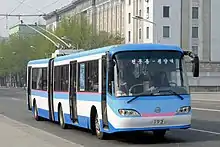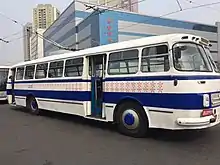Trolleybuses in Pyongyang
The Pyongyang trolleybus system forms part of the public transport network of Pyongyang, the capital city of North Korea, and extends to some of its suburbs.
| Pyongyang trolleybus system | |
|---|---|
 PTW Chollima 90 trolleybus. | |
| Operation | |
| Locale | Pyongyang, North Korea |
| Open | 1962 |
| Status | Active |
| Lines | 10 |
| Infrastructure | |
| Depot(s) | 7 |
| Stock | More than 300 trolleybuses. |
In operation since 30 April 1962, the system was about 57 km (35 mi) long in 2009 and comprised 10 routes.[1]
Services
There are a total of 11 lines in operation. Some former lines were replaced by the tram system that opened in 1989.
| Route Number | Origin | Destination | Notes |
|---|---|---|---|
| 1 | Ryonmot-dong | Pyongyang Railway station | |
| 2 | West Pyongyang | Pyongyang Railway station | |
| 3 | Pyongyang thermal power plant | West Pyongyang | Trolleybuses turn around before the terminus. |
| 4 | Songsin | Songyo | Replaced tram line 1 in its route on the right bank when its section from Songsin to Pyongyang railway station closed.
Former line 4 ran from Songsin Railway station to Hwanggumbol Metro station, replaced by tram line 1 until section over Taedong River closed. |
| 5 | Munsu | Department Store No.2 | Formerly ran to Munsu on different roads, with a stop at East Pyongyang Theatre |
| 6 | Sadong | Department Store No.1 | |
| 7 (closed) | Rangrang | Munsu | Replaced by tram line 2 |
| 8 | Hwanggumbol metro station | Arch of Triumph | Connects Hwanggumbol metro station to Kaesong station. Formerly used to run further from Kwangbok station to Moranbong-guyok. |
| 9 | Ryonmot-dong | Ryongsong | Interurban line to outskirts of Pyongyang |
| 10 | Pyongyang Railway station | Sci-Tech Complex | Newest route. Former line 10 ran from Palgol to Rangrang, replaced by tram line 1 |
| 11 | West Pyongyang | Sopo |
Fleet
Most of the vehicles used on the system are North Korean made; some of them based on the Czech Karosa buses. The fleet also includes Hungarian Ikarus trolleybuses, imported as diesel buses and later reconstructed into trolleybuses.
For the full list, see Trolleybuses in North Korea
 A trolleybus outside the Pyongyang Station.
A trolleybus outside the Pyongyang Station. Pyongyang trolleybus, 2008.
Pyongyang trolleybus, 2008. PTWC trolleybuses.
PTWC trolleybuses. A domestically produced Chollima-091, 2014.
A domestically produced Chollima-091, 2014.
New Rolling Stock

North Korea is manufacturing new trolleybuses domestically, according to footage from the state run Korean Central Television (KCTV).
New model buses appear to be slowly working their way into circulation, with North Korean media reporting on the development of other buses types in Chonjin as part of the recently concluded 70 day labor campaign.[4][5]
Despite the new technology incorporated with the new trolleybuses such as a dual power supply using a battery as a backup and LED displays,[6] they do not have air conditioning.
The Chollima 091 model first appeared in 2010, without a license plate.
The new trolleybuses were subject to news coverage in the Rodong Sinmun, receiving multiple front page headlines subjecting the tests.[7] Kim Jong-un also made visits to the Pyongyang Trolley Bus Factory, with the intention to turn the factory 'into a world-class trolley bus producer'.[8] The first visit in February featured the Chollima-316 trolleybus, while the August visit featued the Chollima-321 trolleybus.[9]
See also
References
- "Trolleybus city: Pyongyang". 3 March 2009. Retrieved 12 August 2011.
- "Pyongyang". transphoto.org. Retrieved 2020-12-10.
- "平壌市無軌道電車(トロリーバス)". 2427junction.com. Retrieved 2020-12-10.
- https://exploredprk.com/articles/new-model-of-trolley-buses-manufactured/
- "Rodong Sinmun". rodong.rep.kp. Retrieved 2020-10-19.
- "平壌市無軌道電車(トロリーバス)車両紹介-万里馬-312型". 2427junction.com. Retrieved 2020-10-19.
- "平壌市無軌道電車(トロリーバス)車両紹介-千里馬-316型". 2427junction.com. Retrieved 2020-10-19.
- Political News Team. "Kim Jong Un Inspects Pyongyang Trolley Bus Factory". rodong.rep.kp. Retrieved 2020-10-19.
- Political News Team. "Supreme Leader Kim Jong Un Watches New-type Trolley Bus and Tram". rodong.rep.kp. Retrieved 2020-10-19.
External links
![]() Media related to Trolleybuses in Pyongyang at Wikimedia Commons
Media related to Trolleybuses in Pyongyang at Wikimedia Commons
- "Trolleybus city: Pyongyang". Trolleymotion.
- Map of Pyongyang Trolleybus. Transphoto.